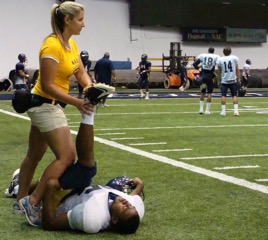A national shift in credentialing for athletic trainers finds Northern Arizona University well positioned for expansion at its Phoenix Biomedical Campus.
The master of athletic training program on NAU’s Flagstaff campus will graduate its first cohort in May 2016, and in July the Phoenix campus will welcome its first entering class.
“The discussion started many years ago about moving the entry level for our profession from a bachelor’s degree to a master’s,” said Debbie Craig, director of the program at NAU. “As the conversation gained more steam, we knew it would be mandated eventually. So we decided to do the legwork and get ahead of it.”
That two-year process resulted in the first master’s students entering NAU’s program in the summer of 2014. Accreditation at NAU—and the anticipated national mandate—occurred in spring 2015.
The Flagstaff campus will continue to welcome 30 new master’s students per year, while the Phoenix Biomedical Campus will begin with 15. The undergraduate program at NAU will end with May’s graduating class.
Craig expects both campuses to benefit from the credentialing change and a heightened focus on the profession.
“As most people are aware, there’s a massively increased focus on concussions at the national level,” Craig said. “Not only are we thrilled there’s more attention for that problem, but it also brings a lot of attention to our profession. It’s the athletic trainers on the sidelines who are the first line of evaluation and protection for the athletes.”
The graduate program begins during the summer with classes in ethics and basic skills. Clinical rotations begin in August. Because NAU and two Flagstaff high schools can accommodate only 10 students each, the second year is spent at clinical sites around the state, with coursework performed online. Craig said the affiliation agreements with statewide clinics are a valuable asset to the program.
“There are fantastic educators who are also athletic trainers, and that’s where we like to send our students,” Craig said. “There is typically only one student at each site, so they have the clinical preceptor’s full attention. There’s a lot of learning that happens during that second year.”
Craig said that besides on-field evaluations, athletic trainers do everything from pre-practice taping to post-practice treatments for injuries that are playable. “For athletes who have had surgical injuries, the athletic trainers will often do all of the rehabilitation to get those athletes back into playing shape,” she said.
New graduates from the program, who often work at high schools, at the intercollegiate level or in rehabilitation centers, can expect starting pay of about $50,000, Craig said.
Applicants to the graduate program generally come from a background of exercise science or kinesiology, Craig said. But any student who takes the established pre-requisite courses and participates in the required number of clinical observation hours may apply.
Craig anticipates the program’s expansion will attract plenty of attention.
“People in Phoenix who are interested but can’t move up to Flagstaff for a year will be thrilled,” she said. “And we’re certainly excited about the facility in Phoenix. It’s a beautiful campus.”



